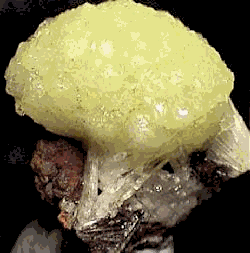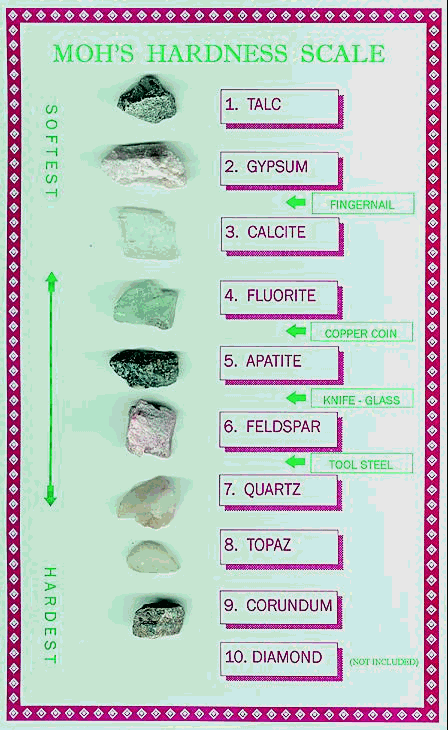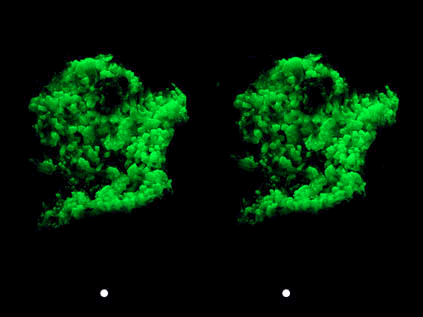 *Note: The color of Adamite is usually green as you can see at the top. White on the sides and a little purple at the bottom of the mineral.
*Note: The color of Adamite is usually green as you can see at the top. White on the sides and a little purple at the bottom of the mineral.
ADAMITE
A mineral is a naturally formed. A mineral must have 4 qualities to be a mineral. Minerals must be a solid, which means it canít be a liquid or a gas. A mineral must be formed in nature which means minerals cannot be made by humans. Minerals must be made from nonliving material, inorganic, which means if it is made from living things it isnít a mineral and lastly a mineral must have a crystalline structure. A crystalline structure means that they have a repeating inner structure. Minerals generally have the same chemical composition throughout it. A mineral in short is a naturally formed, nonliving solid with one crystalline structure. Most minerals are made of compounds of many unlike elements. For example atoms of sodium and chlorine join together to form the mineral Halite.
My mineral is Adamite. Adamite is located in Chile, Atacama, and Chañarcillo. Adamite is part of the Phosphate Class. The Phosphate Class is made up of minerals with a basic chemical unit of tetrahedral (AO
4) and groups with a negative three (-3) charge. Adamite is only used as a mineral specimen and can also be used as part of a collection. Adamite is named after the French mineralogist Gilbert Joseph Adam (1795-1881). *Note: The color of Adamite is usually green as you can see at the top. White on the sides and a little purple at the bottom of the mineral.
*Note: The color of Adamite is usually green as you can see at the top. White on the sides and a little purple at the bottom of the mineral.
The color of a mineral is the color of the outside of the mineral specimen. The color of a mineral is not very effective in finding a specific mineral because you can have many green minerals or many red minerals so color is not a very good technique to use. The Color of Adamite is constantly green payable to trace amounts of copper and uranium. Adamite can also be yellow, very seldom white and infrequently purple due to traced amounts of cobalt.
Luster is the way the light shines off the surface of the mineral specimen. There are three types of groups for luster. Metallic, which is like metal, sub-metallic which, is like rock and metal all-together and last non-metallic, which means it, isnít metallic at all. The luster of Adamite is Vitreous which means that the luster is Non-metallic. It also means that Adamite is like glass when light shines on it.
Specific gravity is the density of a substance divided by the density of water. So if you had a gallon of water and then another gallon bottle filled with feathers and then
Another gallon bottle filled with lead weights then you could tell the specific gravity. The feathers, water, lead weights. So the specific gravity of Adamite is 4.3-4.4.
Also, the density of an object is calculated by Mass/Volume = Density. The density of Adamite  ranges from 4.3 to 4.5 but the average of Adamiteís density is 4.4.
ranges from 4.3 to 4.5 but the average of Adamiteís density is 4.4.
*Note: This is Adamiteís Crystal Habit. Adamiteís crystal habit is called Orthorhombic.
The streak of a mineral is found when you scrape the mineral specimen against an unglazed ceramic tile and the dust or powder left behind is the mineralís streak. The streak never changes. The streak can never be changed even by weathering. The streak is a very reliable technique because the streak is always the same. The streak of a mineral specimen sometimes is different from the mineralís color. The streak of Adamite is white to a pale green. Streak is a very useful technique to use to identify a mineral because each one has a unique streak and since it never changes then you can always identify it.
 The hardness of a mineral is found with Mohís Hardness Scale. This scale was developed by Friedrich Mohs a German Mineralogist. It is found by how it cuts glass and by how well glass scratches the mineral. The scale ranges from 1 to 10. Diamond being the hardest and Talc being the softest. The hardness of Adamite is 3.5. Which means it can be scratched by any mineral over 4 and glass can scratch it. Adamite can be scratched by Apatite, Feldspar, Quartz, Topaz, Corundum, and Diamond. To see the "Moh's Hardness Scale" Picture larger scroll to the bottom and you can see the enlarged chart.
The hardness of a mineral is found with Mohís Hardness Scale. This scale was developed by Friedrich Mohs a German Mineralogist. It is found by how it cuts glass and by how well glass scratches the mineral. The scale ranges from 1 to 10. Diamond being the hardest and Talc being the softest. The hardness of Adamite is 3.5. Which means it can be scratched by any mineral over 4 and glass can scratch it. Adamite can be scratched by Apatite, Feldspar, Quartz, Topaz, Corundum, and Diamond. To see the "Moh's Hardness Scale" Picture larger scroll to the bottom and you can see the enlarged chart.
 *Note: Adamite is Fluorescent. It glows under a short and long UV light.
*Note: Adamite is Fluorescent. It glows under a short and long UV light.
Fracture and cleavage describe the surface of a mineral after it has just been broken. Fracture occurs if a mineral breaks and leaves a rough surface; the terms used to describe the surface are Conchoidal, hackly, irregular and splintery. The Cleavage of Adamite is that it is perfect in two directions at non-right angles to each other. Adamiteís fracture is Conchoidal. Conchoidal is a mineralís habit of fracturing to produce curved surfaces like the interior of a shell
The best indicators are the crystal habit, color, luster, density, fluorescence and associations.
The chemical make up of Adamite is Zn2 (AsO4)(OH). The chemical make up is the elements that combined to create that mineral. Also Zinc arsenate. The molecular Weight of Adamite is 286.71.
 Moh's Hardness Scale
Moh's Hardness Scale